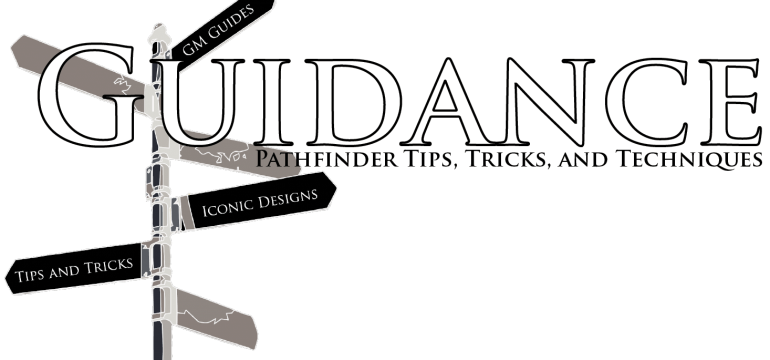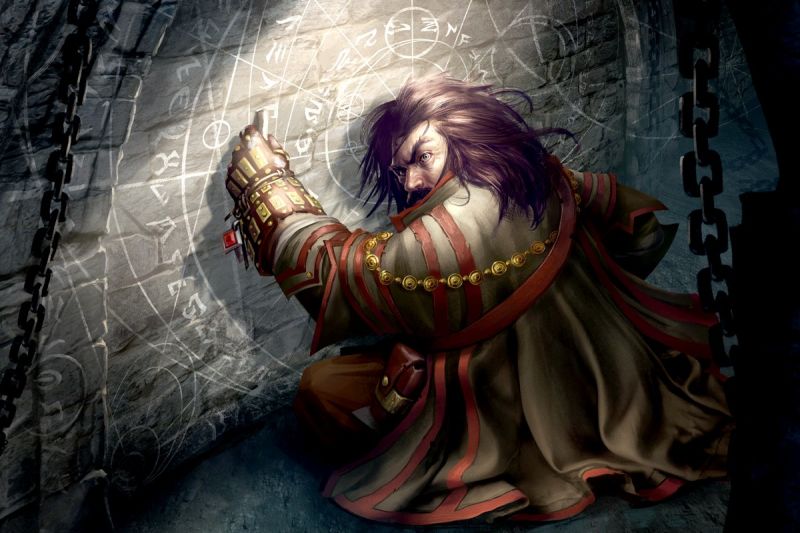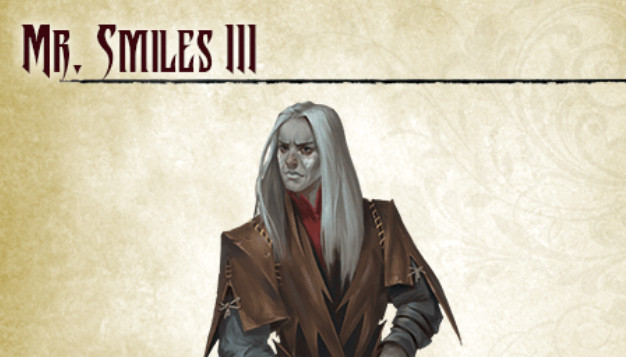Hello everyone, and welcome to Guidance! Well, it’s as I promised last week—I’ve scurried out of the woodworks to give some of my thoughts on this new, big playtest thing that Paizo is currently doing. For more intel on stuff that the Network’s done with the Playtest, I direct you to the following list:
- Ryan and Perram’s Overview Episode of KD:P
- The Staff’s Reactions
- My Reactions after running it at GenCon
- Doomsplay, Episode 1
With this out of the way, I plan to take some time this September talking about my personal thoughts about design decisions made in the Pathfinder Playtest, and while I agree or disagree with them. I can’t promise that all my articles in this series are going to be positive, but I also can’t promise that I’m going to spend hundreds of works dissecting every little decisions that the Pathfinder 2 Designers made. I don’t have time for that, and you don’t have time for that.
Instead, I’m going to focus on things that impacted my choices as a Pathfinder Playtest Player or GM or on issues that people have brought up to me in. So if you have issues, make sure to let me know and maybe I’ll comment on them too! But for today’s article, I’m going to focus on my “Hill to Die On” from the Staff Reactions article that I linked above. For those who don’t know, when we KDN staffers talk about Hills to Die on, we’re talking about positions we have about the Playtest that we’re pretty unwaivering on. If you don’t feel like clinking on the article and scrolling down, brief summary of my “Hill to Die On” is essentially that ancestries in the PF Playtest don’t have depth to them, and that long-term this issue is going to make converting a LOT of races to PF2 ancestries very difficult for Paizo.
Before I can explain this, however, it might help if we go over the difference between depth and complexity in games. Let’s take a slight detour and get busy!
What is Depth?
I think a perfectly succinct definition for what “Depth” is in terms of game design can be summarized by Extra Credits, in their video on the difference between Depth and Complexity in gaming. EC defines depth as, “the number of meaningful choices that come out of one ruleset,” and complexity as “a limiter to the number of meaningful choices that comes out of one ruleset, based on the girth of the ruleset.” To describe this another way, I want you to think about wall paint. Yes, wall paint, the stuff you use to paint walls in your house. People like wall paint because it allows them to customize the way something looks, to make it pretty. Typically the more you paint the inside of your house, the better it looks. Not only in the, “Gee, all the rooms of this dwelling are lovely and colorful” sense, but also because wall paint tends to become more vibrant when you put multiple coats of paint the wall.
That having been said, there is a hard limit to the amount of paint you can put onto a wall. Adding too much paint to a wall causes the paint’s coat to run, while not adding enough causes the paint’s coloration to look wrong. In this analogy, depth is wall paint and complexity is the number of coats of paint you apply to the wall. Not enough complexity and your game lacks depth. Too much complexity and your game’s depth doesn’t look or play good because it’s being marred by excess.
Depth, Complexity, and Ancestries
With the concepts of depth and complexity in mind, let’s look at ancestries. Ancestries in Pathfinder 2 represent the different types of creatures you can play. Humans, elves, goblins, and more are all considered ancestries. Each ancestry includes just over a half-dozen feats that your character can choose from when you’re building your character. You get ancestry feats at odd levels, interchanged with general feats. Generally speaking, the ancestry feat decision is an example of a system with a good depth to complexity ratio. You get a decent-sized list of feats and get plenty to choose from. Most of the feats provided meaningful bits of game power and add to the overall feel of the ancestry.
Where the ancestries start to fall apart, however, is when you consider them as a unified package. How much does a member of any one ancestry have in common with one another, and how meaningful is the choice of ancestry separated from the feats themselves? All ancestries end up granting a net +4 to ability scores and define the race’s speed and vision mostly, but offer very little outside of that. What’s worse, while ability scores are handled in a quantifiable, balanced manner, things like speed and vision aren’t. Let’s take a quick look, without the razzle-dazzle of the ancestry feats distracting us.
- Dwarf: 10 HP, 4 squares of movement, 1 bonus language, darkvision, unburdened
- Elf: 6 HP, 6 squares of movement, 1 bonus language, low-light vision
- Gnome: 8 HP, 4 squares of movement, 1 bonus language, low-light vision
- Goblin: 6 HP, 5 squares of movement, 1 bonus language, darkvision
- Halfling: 6 HP, 5 squares of movement, 1 bonus language
- Human: 8 HP, 5 squares of movement, 1 bonus languages
So, let’s take a look at this and try to build a rules system around it.
Hit Points
the minimum amount of ancestral Hit Points that a character can have is 6, so let’s assume that “buying” 6 Hit Points is worth 1 ancestry point. If so, then we have a progression that looks like this.
- 6 HP = 1 Point
- 8 HP = 2 Points
- 10 HP = 3 Points
Ability Scores
Unless we’re to assume that the designers value some ability scores over others, every ancestry has a total of +4 to their ability scores in the form of +2 to two or more ability scores. If an ancestry has three +2s, then it has an ability flaw of –2 to balance it out. As a result, we can assume the following:
- Two free ability boosts = 1 Point
- Two specific ability boosts, one free ability boost, and one ability flaw = 1 Point
Bonus Languages
All ancestries get two languages. Humans are less set-in-stone, but generally their additional language is tied to their ethnicity. As a result, we’re going to assume the following:
- 2 Specific Languages = 1 Point
- 1 Specific Language + 1 General Language = 1 Point
Speed
Every race has a speed, and the slowest seems to be gnomes at 20 feet and no “unburdened” special ability. For the purpose of this analysis, we’ll assume that dwarves have unburdened as a way to give them 5 extra feet of movement under special circumstances, so we’ll charge it as a 1 ancestry point ability. This gives us the following.
- 20 ft. speed = 1 Point
- 20 ft. speed + unburdened = 2 Points
- 25 ft. speed = 2 Points
- 30 ft. speed = 3 Points
Vision
So, for vision we assume that having no special vision is worth 1 point, something humans and halflings share. The way darkvision is worded makes it definitely seem like it’s an improvement on low-light vision, giving us the following:
- No Vision: 1 Point
- Low-Light: 2 Points
- Darkvision: 3 Points
Final Scores
With this all in mind, let’s total up the ancestral point values of these ancestries!
- Dwarf: 10 HP (3), 4 squares of movement (1), 1 bonus language (2), darkvision (3), unburdened (1)
- Elf: 6 HP (1), 6 squares of movement (3), 1 bonus language (2), low-light vision (2)
- Gnome: 8 HP (2), 4 squares of movement (1), 1 bonus language (2), low-light vision (2)
- Goblin: 6 HP (1), 5 squares of movement (2), 1 bonus language (2), darkvision (3)
- Halfling: 6 HP (1), 5 squares of movement (2), 1 bonus language (2), normal vision (1)
- Human: 8 HP (2), 5 squares of movement (2), 0 bonus languages (1), normal vision (1)
Adding 1 to each of these totals to represent the ability boosts gives us the following results:
- Dwarf: 11 Points
- Elf: 9 Points
- Gnome: 8 Points
- Goblin: 9 Points
- Halfling: 7 Points
- Human: 8 Points
As you can see, these races aren’t greatly balanced when you look outside of their ancestry feats, and honestly, that’s a problem. For humans and halflings to be “balanced”, we would have to assume that they either have better ability boosts (they don’t) or that their ancestral feats are somehow stronger than those of dwarves, elves, gnomes, or goblins (they’re not). I’ll take this another step further and state that expecting ancestry feats to make up for deceits like this hurts the feats system as a whole, since the point of having feats is to have options that are decently balanced against one another.
This “ancestral points” system isn’t perfect, but it does touch upon an important question here—is there really any question on whether or not my system is fair? And my answer to that … is no. There IS no question, because unlike PF1 where race had special abilities of varying degrees of power that could offset for point balances like this, the benefits of an ancestry are simple to quantify because they’re a sliding scale of power. To tie it back to what I was saying earlier, there is NO complexity in ancestries outside of ancestry feats, and since those feats are supposedly balanced against one another that means that baseline some races are just quantifiably better than others. (Dwarf is an absolute STEAL as you can see.)
What’s worse is that this mathematical issue that I pointed out doesn’t even consider the thing I specifically don’t like about this system—the flavor issues.
From a Flavor Issue
Pathfinder is an awesome world filled with a delightful assortment of ancestries beyond the eight core options detailed in the Playtest Core Rulebook, and since we know that the designers’ intentions is to “update the world” to to PF2 without causing a major calamity, we know that all of the races from PF1 are canon in the updated world. After all, you can merge the magus class into the wizard class without causing issues because ultimately, class is an abstract concept used by players to design characters, not a real job or vocation in the world of Golarion. (In fact, most of the non-core classes were never even properly placed in the world during 1st Edition.) But ancestries? You can’t just say, “Oops, all of these strixes are now something else,” without some major Spellscar-level shenanigans, which is why you’ll constantly hear me say that it’s more important for Paizo to update PF1’s races then classes quickly. We already know these things existed, and you gave us the power to make them into characters in 1st Edition. Keeping them away for too long invalidates those characters in your new edition, which WILL stop people from switching over quickly.
But I digress.
The linear nature of power within the base ancestries described above is going to cause a LOT of problems for Paizo when they’re trying to figure out how to translate races from 1st Edition into ancestries for 2nd Edition because this system doesn’t have the complexity to handle nonhuman biology. Don’t believe me? Okay.
Here are some abilities that races in PF1 have canonically that this system has no way to adjust its power for. I’ll even skip races that should really be an add-on to another race, like how half-elves and half-orcs are add-ons to humans.
The “I Can Pass for a Human and Therefore Can’t Really be Slower Then They Are” Club
- Vishkanya are defined by their naturally toxic blood. That’s literally their schtick.
- Kitsune and Reptoids all change shape.
The “My Ancestry Has a Movement Type That We’re Born With” Club
- Grippli and vanaras have a climb speed.
- Merfolk have a swim speed.
Solutions
I could keep going, but I’m not going to because you guys get my point (I hope). Instead, let’s talk briefly about some ways that Paizo could fix this issue, thereby futureproofing their system for when they inevitably have to deal with this.
- Give every ancestry two ancestry feats at first level. This doesn’t solve anything, really, other than increase character power. It also doesn’t stop people from being able to break assumptions about people from each ancestry. (For example, that all kitsune can change shape.)
- Give every ancestry a bonus, locked-in ancestry feat. This would be like how druids get a druid feat that’s determined by their druidic order; its technically a feat choice, but its a choice that’s locked in for you. This would make it so you definitely don’t have any “why can’t this person do this basic thing I thought all members of their species could do?” issues, but it does have the downside that it doesn’t correct the power imbalance we noted before because all ancestry feats are assumed to be of similar power.
- Give every ancestry a “base ability”. This is by far the easiest way to solve this problem—every ancestry has a base ability that’s roughly as good as an ancestry feat that they get just for being a member of that ancestry. Since this ability isn’t a feat, it can be “adjusted” for the relative power of the other things the ancestry has, like their speed and whatnot.
Ultimately, I think adding a base ancestry ability is the best option, but I am curious to hear yours! Please tell me what you think in the comments below, or shoot me a tweet about it at my Twitter Handle (see below). Next week I’m going to talk a bit about the Resonance system, it’s apparent purpose, and how it’s working as a means to fill that purpose. See you then!

Alexander “Alex” Augunas has been playing roleplaying games since 2007, which isn’t nearly as long as 90% of his colleagues. Alexander is an active freelancer for the Pathfinder Roleplaying Game and is best known as the author of the Pact Magic Unbound series by Radiance House. Alex is the owner of Everyman Gaming, LLC and is often stylized as the Everyman Gamer in honor of Guidance’s original home. Alex also cohosts the Private Sanctuary Podcast, along with fellow blogger Anthony Li, and you can follow their exploits on Facebook in the 3.5 Private Sanctuary Group, or on Alex’s Twitter, @AlJAug.





